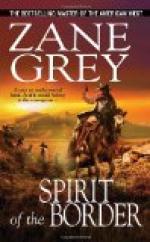When the young minister came, however, to study the hostile Indians that flocked to the village, any conclusive delineation of character, or any satisfactory analysis of their mental state in regard to the paleface religion, eluded him. Their passive, silent, sphinx-like secretiveness was baffling. Glickhican had taught him how to propitiate the friendly braves, and with these he was successful. Little he learned, however, from the unfriendly ones. When making gifts to these redmen he could never be certain that his offerings were appreciated. The jewels and gold he had brought west with him went to the French traders, who in exchange gave him trinkets, baubles, bracelets and weapons. Jim made hundreds of presents. Boldly going up to befeathered and befringed chieftains, he offered them knives, hatchets, or strings of silvery beads. Sometimes his kindly offerings were repelled with a haughty stare; at other times they would be accepted coldly, suspiciously, as if the gifts brought some unknown obligation.
For a white man it was a never-to-be-forgotten experience to see eight or ten of these grim, slowly stepping forest kings, arrayed in all the rich splendor of their costume, stalking among the teepees of the Village of Peace. Somehow, such a procession always made Jim shiver. The singing, praying and preaching they heard unmoved. No emotion was visible on their bronzed faces; nothing changed their unalterable mien. Had they not moved, or gazed with burning eyes, they would have been statues. When these chieftains looked at the converted Indians, some of whom were braves of their nations, the contempt in their glances betrayed that they now regarded these Christian Indians as belonging to an alien race.
Among the chiefs Glickhican pointed out to Jim were Wingenund, the Delaware; Tellane, the Half-King; Shingiss and Kotoxen—all of the Wolf tribe of the Delawares.
Glickhican was careful to explain that the Delaware nation had been divided into the Wolf and Turtle tribes, the former warlike people, and the latter peaceable. Few of the Wolf tribe had gone over to the new faith, and those who had were scorned. Wingenund, the great power of the Delawares—indeed, the greatest of all the western tribes—maintained a neutral attitude toward the Village of Peace. But it was well known that his right-hand war-chiefs, Pipe and Wishtonah, remained coldly opposed.
Jim turned all he had learned over and over in his mind, trying to construct part of it to fit into a sermon that would be different from any the Indians had ever heard. He did not want to preach far over their heads. If possible, he desired to keep to their ideals—for he deemed them more beautiful than his own—and to conduct his teaching along the simple lines of their belief, so that when he stimulated and developed their minds he could pass from what they knew to the unknown Christianity of the white man.
His first address to the Indians was made one day during the indisposition of Mr. Wells—who had been over-working himself—and the absence of the other missionaries. He did not consider himself at all ready for preaching, and confined his efforts to simple, earnest talk, a recital of the thoughts he had assimilated while living here among the Indians.




